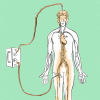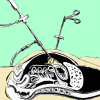From "silent teachers" to models
- PMID: 25333490
- PMCID: PMC4205111
- DOI: 10.1371/journal.pbio.1001971
From "silent teachers" to models
Abstract
For decades, embalmed cadavers have played an important role in teaching anatomy to the scientists and doctors of the future. Most anatomy departments use a traditional formaldehyde-based embalming method, but formalin embalming makes the bodies very rigid, which limits their usefulness for procedures other than dissection. A more recent embalming method developed by W. Thiel has allowed these "silent teachers" to take on a further role in applied anatomy research and teaching: to act as models for surgical training and medical research.
Conflict of interest statement
The authors have declared that no competing interests exist.
Figures


References
-
- Lin SC, Hsu J, Fan V (2009) “Silent virtuous teachers”: anatomical dissection in Taiwan. BMJ 339: b5001. - PubMed
-
- Bohl M, Bosch P, Hildebrandt S (2011) Medical students' perceptions of the body donor as a “First Patient” or “Teacher”: A pilot study. Anat Sci Educ 4: 208–213. - PubMed
-
- Lempp HK (2005) Perceptions of dissection by students in one medical school: beyond learning about anatomy. A qualitative study. Med Educ 39: 318–325. - PubMed
-
- Kotzé SH, Mole CG (2013) Talking about death: implementing peer discussion as a coping mechanism to overcome fears about dissection, death, and dying. Anat Sci Educ 6: 191–198. - PubMed
-
- Jones TW, Lachman N, Pawlina W (2014) Honoring our donors: A survey of memorial ceremonies in united states anatomy programs. Anat Sci Educ 7: 219–223. - PubMed
MeSH terms
LinkOut - more resources
Full Text Sources
Other Literature Sources

